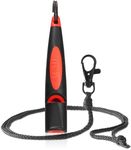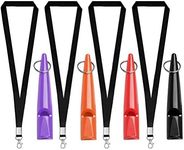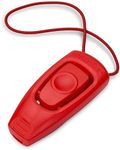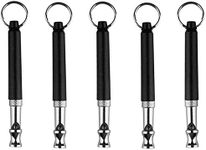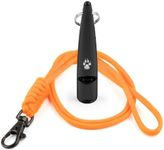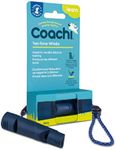Buying Guide for the Best Dog Whistles
Choosing the right dog whistle can make training your dog more effective and enjoyable. Dog whistles are used to communicate with your dog over long distances and can be a great tool for training commands. When selecting a dog whistle, it's important to consider several key specifications to ensure it meets your needs and your dog's needs. Here are the key specs to consider and how to navigate them.Frequency RangeThe frequency range of a dog whistle refers to the pitch of the sound it produces. This is important because different dogs respond to different frequencies. Some whistles are adjustable, allowing you to find the perfect pitch for your dog. Generally, higher frequencies are better for long-distance communication, while lower frequencies are more suitable for close-range training. If you have a young dog or a dog with good hearing, a higher frequency might be more effective. For older dogs or those with hearing issues, a lower frequency might be better.
MaterialDog whistles can be made from various materials, including plastic, metal, and wood. The material affects the durability and the sound quality of the whistle. Metal whistles are typically more durable and produce a clearer sound, making them ideal for outdoor use and long-term training. Plastic whistles are lightweight and often more affordable, but they may not be as durable. Wooden whistles can produce a softer, more natural sound, which some dogs may prefer. Consider where and how often you will use the whistle to choose the right material for your needs.
AdjustabilitySome dog whistles come with adjustable frequency settings, allowing you to fine-tune the pitch to suit your dog's hearing. This is important because it gives you the flexibility to find the most effective frequency for your dog. Adjustable whistles are particularly useful if you have multiple dogs with different hearing ranges or if you are unsure which frequency your dog will respond to best. If you are new to using dog whistles, an adjustable model can be a good choice to start with.
Size and PortabilityThe size and portability of a dog whistle are important for convenience and ease of use. Smaller, lightweight whistles are easier to carry around, especially if you plan to use them during walks or outdoor training sessions. However, smaller whistles can be easier to lose, so consider a model with a lanyard or keychain attachment. Larger whistles may be more durable and easier to handle, but they might not be as convenient to carry. Think about your training environment and how you will carry the whistle when making your choice.
Sound ConsistencySound consistency refers to the whistle's ability to produce the same sound each time it is used. This is crucial for training, as dogs rely on consistent cues to learn commands. A whistle that produces a consistent sound will help your dog understand and respond to your commands more effectively. Look for reviews or product descriptions that mention the whistle's reliability and consistency. If possible, test the whistle to ensure it produces a clear, consistent sound each time you use it.

